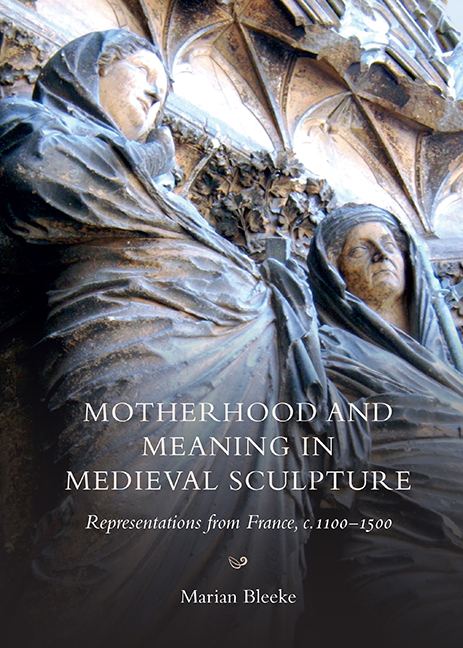Book contents
- Frontmatter
- Contents
- List of Illustrations
- Acknowledgments
- Introduction: Motherhood and Meaning in Medieval Sculpture
- 1 Motherhood as Transformation: From Annunciation to Visitation at Reims
- 2 Motherhood as Monstrosity: The Moissac Femme-aux-serpents and the Transi of Jeanne de Bourbon-Vendôme
- 3 Resurrecting Lazarus: The Eve from Saint-Lazare at Autun
- 4 Visualizing Parturition: Devotional Sculptures of the Virgin and Child
- Afterword: Motherhood and Meaning: Medieval Sculpture and Contemporary Art
- Bibliography
- Index
- Already Published
3 - Resurrecting Lazarus: The Eve from Saint-Lazare at Autun
Published online by Cambridge University Press: 29 May 2021
- Frontmatter
- Contents
- List of Illustrations
- Acknowledgments
- Introduction: Motherhood and Meaning in Medieval Sculpture
- 1 Motherhood as Transformation: From Annunciation to Visitation at Reims
- 2 Motherhood as Monstrosity: The Moissac Femme-aux-serpents and the Transi of Jeanne de Bourbon-Vendôme
- 3 Resurrecting Lazarus: The Eve from Saint-Lazare at Autun
- 4 Visualizing Parturition: Devotional Sculptures of the Virgin and Child
- Afterword: Motherhood and Meaning: Medieval Sculpture and Contemporary Art
- Bibliography
- Index
- Already Published
Summary
Perched on both knees and her right elbow, the woman rests amidst thick fronds of fruiting foliage that relate closely to the forms of her body (Fig. 16). A first frond begins in front of her elbow, grows upwards and inwards towards her arm, bends back along with the angle of her hand, arcs around her face, and then bursts open into leaves and fruits just above her head. A second stem arcs upward behind her upper body before likewise bursting into bloom just above her outstretched left arm. A third twists its way upward in front of her lower torso: unlike the others, this frond expands outward into leaves and fruits that grow along its whole curving length. Two large leaves topped with seeded fruits extend onto the woman's abdomen and intersect there with its defining lines. Two others curl backward in space around her buttocks and thighs, even as this part of her body twists sharply downwards towards the ground. A fourth frond enters the sculpture from beyond a break in its block and is bent into a horizontal direction by a disembodied clawed hand; this bend in the frond echoes that in the woman's knees below. By bending the frond, furthermore, the clawed hand directs one of its fruits directly into the woman's outstretched hand, an intersection that is emphasized as the third frond passes behind her wrist. Following the line of her left arm forward connects the rounded form of the fruit in her hand to the similarly rounded forms of her breasts, suggesting that they likewise be seen as the fruits of the second frond, as it passes behind her body in line with them. Finally, the curves of the first frond, along with the gesture of the woman's bent right arm, call attention to her remarkably detailed and expressive face, which turns away from her extended arm and body (Fig. 17). She has a small, tight mouth, a damaged nose, and huge eyes. Her eyes are deep set with heavy eyelids, bulging eyeballs, deeply drilled pupils, and sharp lower ridges. A faint mark appears in the inner corner of her left eye and suggests the possibility of a tear forming there.
- Type
- Chapter
- Information
- Motherhood and Meaning in Medieval SculptureRepresentations from France, c.1100-1500, pp. 87 - 119Publisher: Boydell & BrewerPrint publication year: 2017

